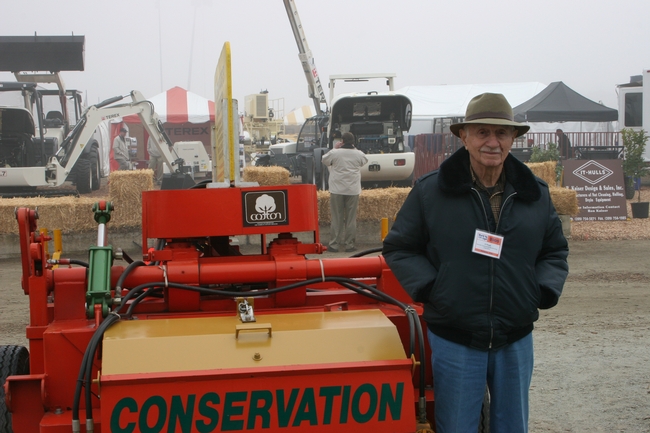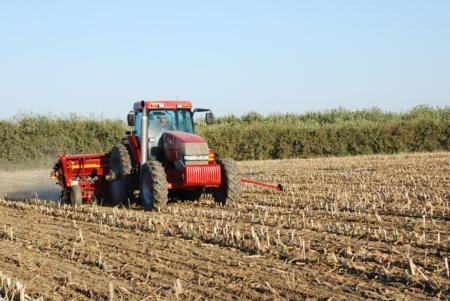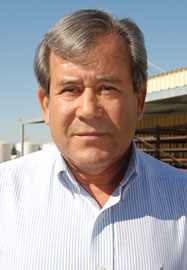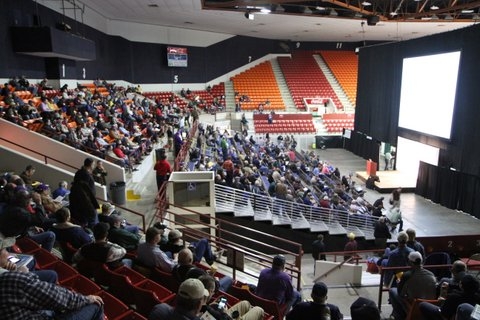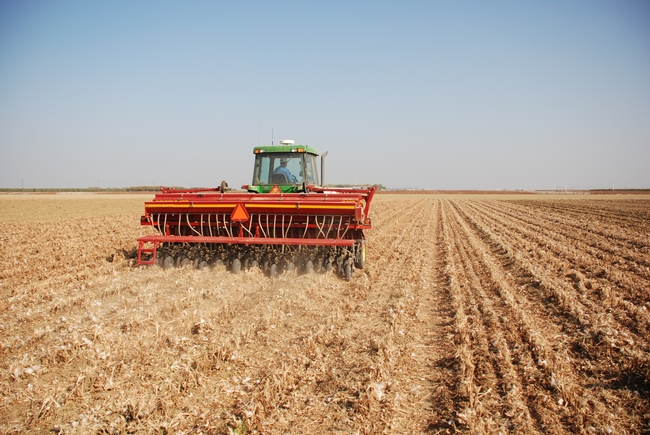Conservation agriculture news
Farmers cutting costs by cutting tillage
Recent investigations conducted by UC's Conservation Agriculture Systems Innovation (CASI) Center shed light on opportunities farmers have for cutting production costs in their cropping systems by reducing tillage. Founded in 1998, CASI is a large group of diverse members including UC researchers, farmers, private sector, NRCS and other public agency partners who work together to develop and spread information about production systems alternatives that aim to increase profitability and efficiencies, conserve resources and be readily adaptable to local marketing and environmental conditions.
Citing a number of studies the group has published over the past several years at a recent workgroup meeting in Five Points, Calif., CASI workgroup chair, Jeff Mitchell, summarized the potential savings that can be gained by a variety of reduced tillage approaches as being typically between $50 and $140 per acre per season depending on the particular crop and set of practices or equipment that are used.
“For a number of crops including tomato, cotton, silage corn, sorghum, and sugar beets, that we've run the numbers for, this seems to be the range of savings that can be achieved by using various minimum tillage implements that combine customary tillage operations into fewer passes, or more classic forms of conservation tillage such as strip-tillage or no-tillage," Mitchell said.
CASI Workgroup tomato farmers, Alan Sano, Jesse Sanchez and Steve Fortner of Firebaugh have all seen this range of cost reductions since moving to minimum tillage practices that they couple with subsurface drip irrigation and cover crops when water is available to improve their soil's tilth, water movement and storage.
“Our yields are actually higher now with about four inches less water than when we were furrow irrigating and using conventional tillage,” reports Jesse Sanchez in a recent survey that is available at the CASI website http://casi.ucanr.edu/
Tom Barcellos, a Tipton, Calif., dairy farmer and President of Western United Dairymen, calculates savings of about $70 per acre that he has accomplished with strip-till and no-till silage corn over his former conventional intercrop tillage practices. There are also savings in time as well as wear and tear on equipment that he has achieved since transitioning to these conservation tillage practices in 2003.
Alan Wilcox, another CASI workgroup founding member and minimum tillage equipment entrepreneur in Walnut Grove, Calif. has created a tillage cost calculator tool that he uses to determine savings that may result from reduced pass practices.
“Knowing the true costs of tillage is essential,” Wilcox says, “since tillage is one of the few things in their overall budgets that farmers can control.”
Pioneering conservation agriculturalist Al Ruozi, 97, retires
Mr. Al Ruozi of Interstate Manufacturing received the Conservation Tillage Workgroup's Award for Industry Innovation in 2005. He has made very significant contributions to conservation tillage in California through his inventions, his vision for a better way to manage the soil, and the sheer persistence and single-minded purpose that he has shown throughout his life.
Al was born in 1917 in Bakersfield, Calif. As a young boy, he learned, as he says, “That you have to walk the furrow to find out what the ground is like,” and early on he realized that “there was a better way to manage the soil” than was being done.
In the early 1950s, he made the precursors of his patented Shredder Bedder to help potato farmers who needed a way to have cotton roots dislodged and unearthed prior to planting potatoes.
In the late 1950s he had perfected the Shredded Bedder and the potential benefits of this machine for cotton stalk and soil management were quickly shown.
Al's company, Interstate Manufacturing, then went on to build 175 machines that were used throughout the southern San Joaquin Valley and even back at Auburn University in Alabama.
With Lyle Carter, a USDA ARS scientist at the Shafter, Calif., research facility, Al recognized quite early on the importance of trying to leave beds in the same place, and thereby effectively perform zone production.
In 1967, Al responded to a challenge by taking his machine down to Brawley, Calif., where it was compared to standard cotton stalk management approaches and it proved successful. This test subsequently helped alter CDFA's rule for pink bollworm management by acknowledging that a power-driven shredder performed successfully for postharvest cotton management.
Al has met and overcome many challenges in his life as a result of his vision, intellect and innovation.
“It has been a battle,” he says, “since he put his first two pieces of iron together.”
He developed systems that would save, again in his words, "oil, toil, and soil.”
Al has been fighting the battle to develop improved tillage management systems that most of us have only recently begun, for over six decades.
CASI is extremely proud to count Al Ruozi within our ranks and we greatly appreciate his dedication and outstanding accomplishments in the field of conservation tillage.
Congratulations, Al, on your retirement!
Conservation agriculture applies to California
Mitchell, the chair of the UC Conservation Agriculture Systems Innovation Center, made the comment at the 6th World Congress on Conservation Agriculture in Winnipeg, Manitoba, last month.
After attending the congress, Mitchell said he is more strongly convinced that greater efficiencies and brighter economics in California agriculture could be achieved by employing conservation principles.
“Focusing on soil care will improve soil water intake and storage,” he said. “Reducing soil water evaporation can be achieved by preserving surface residues. Together these steps reduce energy use and greenhouse gas emissions – very important goals.”
The Manitoba congress drew more than 350 participants representing 47 countries. It was co-sponsored by the Conservation Agriculture Systems Alliance, the Conservation Technology Information Center, and the Canadian Soil and Water Conservation Society. California's CASI was represented by Mitchell and Monte Bottens, president of California Ag Solutions of Madera, a consulting and custom fertilizer support company.
Speakers at the conference suggested conservation agriculture principles are “transformative and not merely incremental means for achieving the kinds of change must be made to meet the global challenges of food production and natural resource conservation in the 21st Century,” Mitchell said. Modestly tweaking today's conventional agricultural systems, he said, “is not an option.”
Today conservation agriculture is used on about 11 percent of the world's total arable land. Implementation is increasing at an annual rate of about 7 to 8 million hectares, according to the U.N.'s Food and Agricultural Organization. Nearly half of the world's conservation agriculture acreage is found in the developing world. The South American countries of Brazil, Argentina and Paraguay, where the movement had its beginnings as a farmer-led process dating back to the mid-1970s, has about 80 percent implementation.
During his keynote address at the conference, David Montgomery, University of Washington professor of geology and author of Dirt: The Erosion of Civilizations, issued a “call to action.”
“Global soil degradation,” he said, “is an under-appreciated environmental crisis that occurs because of how we farm. We need to be more creative in terms of how we're intensifying agriculture to feed the post-oil world without cheap, fertilizer-intensive agriculture.”
Congress speaker Dwayne Beck, agronomy professor at South Dakota State University, also sounded an alarm.
“Never in history has mankind knowingly faced this type of impending catastrophe,” Beck said. “It is time to stop doing incremental things and start doing transformative things. You do not cross a chasm in two steps. We need to focus on where we want to be and emphasize systems, not details; actions, not reactions; and commitment, not merely involvement.”
CASI members are working with foundations and granting agencies to better position the organization to support implementation of conservation agriculture in California. For more information, contact Mitchell at (559) 303-9689.
CASI participation in national conferences in 2014
Members of Conservation Agriculture Systems Innovation center participated in four national conferences in January and February, 2014. Following are summaries of the events and take-home messages most relevant to improving California farming systems.
2014 Empire State Producers Expo
Syracuse, N.Y.
Jan. 22, 2014
CASI member Jesse Sanchez of Sano Farms in Firebaugh, Calif., interacted with about 100 vegetable farmers in New York as part of the 2014 Empire State Producers Expo in Syracuse. Jesse was invited to travel to this event, but due to the snow storm that hit the region the day before the conference, he was obliged to conduct his discussion on reduced tillage tomatoes and cover crops in California via SKYPE. According to Carol McNeil, the Cornell University organizer of the event, Jesse's involvement in this session was much appreciated by the New York audience. Congratulations to Jesse Sanchez on this very nice honor!
18th Annual Winter Conference of No-till on the Plains and 2014 AIM (Agriculture's Innovative Minds) Symposium
Back to the Basics – Managing Water and Nutrients
Salina, Kan.
Jan. 28-30, 2014
CASI chair Jeff Mitchell participated in the 18th Annual Winter Conference of No-till on the Plains and 2014 AIM (Agriculture's Innovative Minds) Symposium, which brought together more than 1,400 farmers from states stretching from Colorado in the West to Ohio in the East. No-till on the Plains, Inc. is a 501.c3 non-profit educational organization that works to educate farmers and others on the benefits of continuous no-till farming and other practices that lead to profitable and regenerative farming operations. The association prides itself as a top-notch farmer-to-farmer exchange for practical, reliable information. The learning opportunities afforded by the conference were unparalleled in their effectiveness and quality. Innovative no-till farmers, researchers and leaders from around the U.S. and Canada were on the program. CASI received several quite gracious offers from participating farmers. I heartily encourage CASI members to consider taking part in the annual winter conferences of No-till on the Plains in coming years. For more information, see the conference website at http://www.notill.org.
High Residue Farming Systems in the Irrigated West Conference
Salt Lake City, Utah
February 6-7, 2014
CASI members Michael Crowell, a dairy farmer in Turlock; Dennis Chessman, USDA Natural Resource Conservation Services state agronomist for California; and Jeff Mitchell of UC Davis, were invited to participate in a meeting in early February in Salt Lake City, Utah, on high-residue farming systems. The event included groups of farmers, NRCS conservationists and university representatives from Washington, Oregon, Utah, Idaho, Arizona, New Mexico and California. There was a lively exchange of information on high-residue farming activities used throughout the irrigated western states. Presentations were made by farmers, NRCS and university teams for each state. Joint planning discussions on how to do more to increase education about innovative farming systems were also held. In addition, Marilyn Lockhart of Montana State University gave a seminar on adult learning strategies. Our three CASI representatives at this event will now be working to set up a network of farm demonstration evaluations on high-residue farming systems in California.
National Cover Crops and Soil Health Conference
Omaha, Neb.
February 18-19, 2014
More than 300 farmers, agri-business representatives, USDA-Natural Resource Conservation Services staff, university and government agency people came together in Omaha, Neb., and about 600 connected online to plan how the group can work together to increase cover crop use around the nation from about 2 million acres today to 20 million or more by 2020. The group acknowledged that the many obstacles in the way of reaching the goal – less land available for production, increasingly variable weather, and the need to produce more crops – will require wide adoption new farming practices. Implementation of better soil management will be crucial. Cover cropping is the next most important means to achieving improved, more efficient, biologically active soils. During the conference, a number of very innovative cover crop systems and farmers from around the country were showcased. By any measure, little exists in California's Central Valley today that approaches the level of soil care that these cover crop farming champions are achieving. The valley's soils are not immune to soil degradation and could be improved by paying more attention to the core principles of soil health being promoted by the USDA-NRCS.
The four fundamental principles of this initiative are:
- Minimizing soil disturbance
- Maximizing the diversity of plants in the rotation and using cover crops
- Keeping living roots in the soil as much as possible
- Keeping the soil covered with plants and plant residues at all times
These principles provide a platform for achieving more resilient, more efficient and biologically active soils. While conference participants generally agreed that more research is needed, they also agreed that we now have sufficient information and experience to move forward with practices that improve soil health and resiliency. As Pennsylvania cover crop and no-till farmer Steve Groff put it in his concluding comments at the end of the conference, “It is about economics, but it is more than economics. It is the right thing to do.” That encouragement to move forward in working to improve the health of our soils was a clear, inspiring mandate that came out of the conference. But so was the sober realization that without changing behaviors and having soil health principles more widely adopted, soil improvement will not be achieved. Thus, several sessions during the second day of discussions were dedicated to developing regional action plans for how best to address the challenges of adoption.
Compared to the number of shining examples of the cover crop and soil health farmer champions who were given opportunities to share their innovations at the conference, it is only fair and accurate to say that California has far to go in increasing momentum in soil health. The challenge will be to develop suitable adaptations of the basic principles for California's diverse production environments.
Additional information about the conference is available at the conference website:
http://www.sare.org/Events/National-Conference-on-Cover-Crops-and-Soil-Health
Additional 'ecosystem services' can be found on no-till tomato and cotton farms
UC research has shown that conservation agriculture practices – such as cover cropping and no tillage – are generating additional "ecosystem services" in West Side cotton and tomato production.
"Attributing ecosystem services to farming is an emerging trend in assessing the benefits of agricultural operations," said Jeff Mitchell, UC Cooperative Extension specialist in the Department of Plant Sciences at UC Davis. "Resource management systems on today’s farms can provide significant benefits to air, water, and soil resources and furnish wildlife habitat. We've now determined that farmers who use cover crops and no-till practices are furnishing still more ecosystem services."
Since 1999, a team of UC researchers, local farmers, Natural Resource Conservation Service conservationists and private sector partners have compared plots at the UC West Side Research and Extension Center managed with cover crops and no tillage to adjoining plots managed with traditional tillage approaches.
"We have seen striking changes in soil properties after sustained cover cropping and no-till management," Mitchell said.
With eight inches of supplemental irrigation over the 14-year period, cover crops produced more than 19 tons of organic matter or about 7 tons of carbon per acre. This biomass resulted in a 23 percent increase in soil carbon in the cover cropped system that was ‘green manured,’ or incorporated back into the soil with tillage, and a 74 percent increase in soil carbon in the no-till cover crop system.
The research team also reported similar increases in total soil nitrogen, with 19 percent more in the green manured cover crop and 59 percent more in the no-till cover cropped system. The value of these changes relates not only to improving favorable soil attributes – such as water holding capacity, reduced runoff and more available nitrogen – but also to the fact that these soils are now serving as greater 'sinks' for carbon and nitrogen.
"That means there is reduced likelihood these elements will enter the atmosphere as greenhouse gases or be leached to groundwater," Mitchell said.
Mitchell said the team also measured increased levels of soil aggregation, which is related to higher water infiltration and greater soil water storage capacity when cover crops and no-tillage are used.
This long-term research continues at the West Side Research and Extension Center to further determine tradeoffs associated with cover cropping and no-tillage practices in terms of water use, input costs and ecosystem service benefits. Dan Munk, UC Cooperative Extension advisor in Fresno County and project partner, points out that this long-term 'systems' work is important because it allows the opportunity to fully assess both the overall costs and benefits of alternative practices.
More information may be found at the Conservation Agriculture Systems Innovation website at http://casi.ucanr.edu/.

